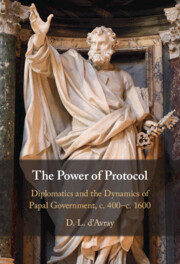Book contents
- The Power of Protocol
- The Power of Protocol
- Copyright page
- Dedication
- Contents
- Plates
- Acknowledgements
- Abbreviations
- Preface
- 1 Introduction
- 2 The History of Papal Diplomatics
- 3 Papal Documents, c. 400–c. 1150
- 4 The Religious Governance of the Latin World, 1150–1378
- 5 From Schism to Counter-Reformation, c. 1378–c. 1600
- 6 Retrospective: Some Long-Term Continuities
- Transcriptions
- Reproductions
- Plates
- Bibliography
- Index
3 - Papal Documents, c. 400–c. 1150
Published online by Cambridge University Press: 20 July 2023
- The Power of Protocol
- The Power of Protocol
- Copyright page
- Dedication
- Contents
- Plates
- Acknowledgements
- Abbreviations
- Preface
- 1 Introduction
- 2 The History of Papal Diplomatics
- 3 Papal Documents, c. 400–c. 1150
- 4 The Religious Governance of the Latin World, 1150–1378
- 5 From Schism to Counter-Reformation, c. 1378–c. 1600
- 6 Retrospective: Some Long-Term Continuities
- Transcriptions
- Reproductions
- Plates
- Bibliography
- Index
Summary
While Late Antique decretals were being transmitted to new generations, popes corresponded with kings and emperors, by the mid-to-late eighth century at times in surprisingly faulty Latin, and a new genre of papal document appeared alongside them, solemn privileges, written on papyrus, two or three meters long, mostly for monasteries. Not much thought was required to compose them, as beneficiaries brought drafts of the substantive part and a formulary supplied the top and the tail. What exactly these privileges granted is a matter of debate. They were written in a script descended from late Roman cursive and hard to read. This was probably an advantage. The archaic script concealed bad Latin. And the appearance would have inspired awe. In the eleventh century the late Roman script and the long papyrus format were abandoned, to be replaced by new devices to make the document impressive. What exactly they were granting to monasteries became clearer in the twelfth century.
- Type
- Chapter
- Information
- The Power of ProtocolDiplomatics and the Dynamics of Papal Government, c. 400 – c.1600, pp. 38 - 76Publisher: Cambridge University PressPrint publication year: 2023



